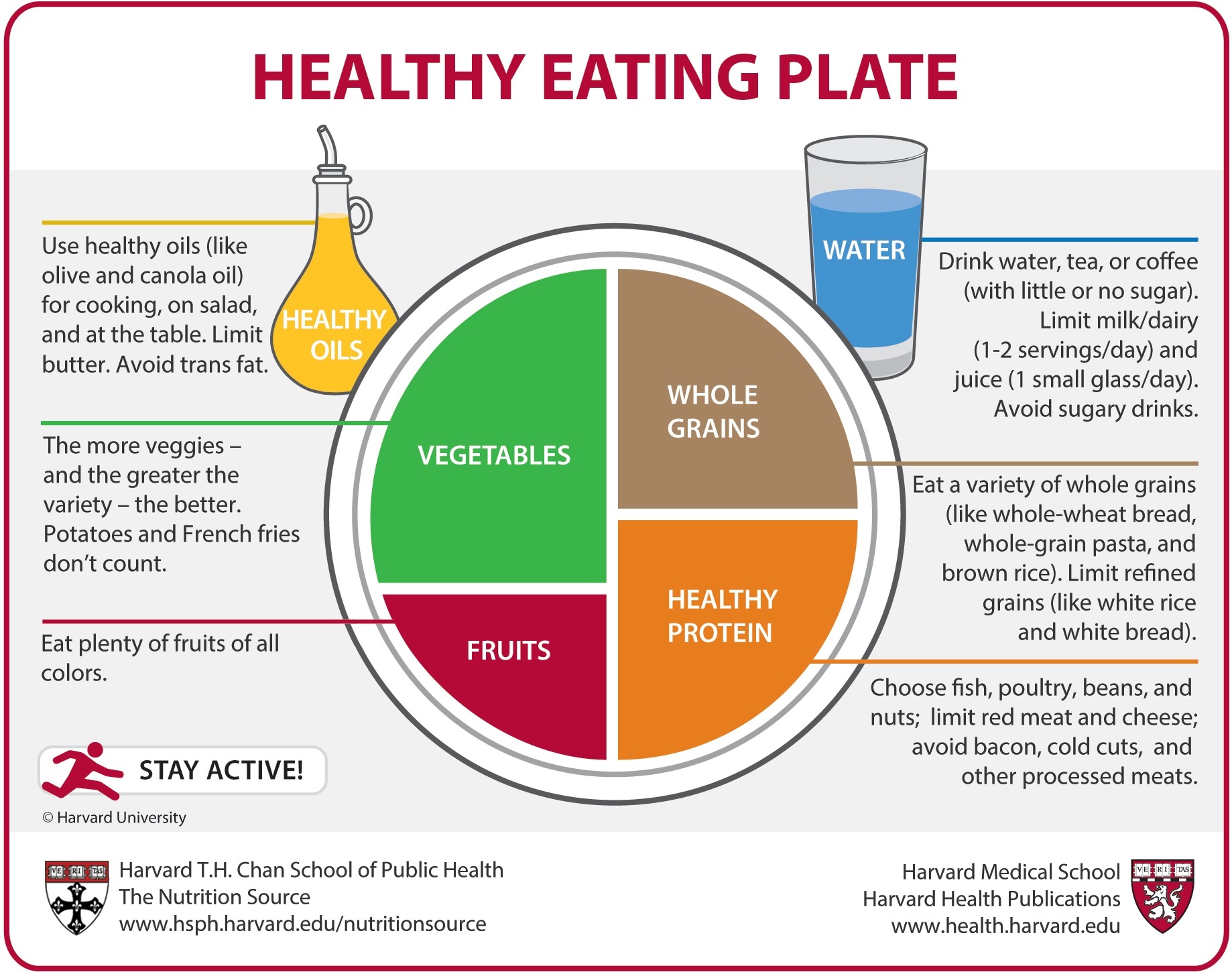Nutrition & Supplements
Nutrition & Supplements
A healthy diet and weight (i.e., having a normal Body Mass Index (BMI)< 25) have many health benefits including decreasing the risk of depression, type 2 diabetes, hypertension, and age-related cognitive decline. A healthy diet also decreases the risk of developing and dying from cardiovascular disease and cancer. These are all important reasons to adopt a healthy diet, but what do we know about diet and chronic pain?
What does diet have to do with pain?
Diets that are high in fruits vegetables, whole grains (e.g., brown rice, oatmeal), nuts, seeds, seafood, legumes (e.g., black beans and lentils), and healthy oil and fats (e.g., olive and canola oil), while limiting salt, red or processed meat (e.g., bacon and luncheon meat), added sugars, and unhealthy fats (e.g., butter and coconut oil) is a high quality diet
Filling Your Plate With a High Quality Diet
The quality of our diet can also affect the symptoms that occur with chronic pain, such as stiffness and depression. Based on many years of studies the United States Department of Agriculture (USDA) has defined what makes up a high quality diet
| TABLE 1. How to Fill Your Plate for A High Quality Diet | |
|---|---|
| Food | Quantity |
| Fruits and vegetables | ½ of every meal |
| Whole grains | ¼ of every meal |
| Legumes and/or animal proteins | ¼ of every meal |
| Water | Primary beverage |
| Nuts | Small handful daily |
| Oils/fats | In moderation |
| Salt | 2,500 mg daily (1 teaspoon) |

Serving Size Guide
| TABLE 2. | ||
|---|---|---|
| Dietary Serving Sizes | ||
| Food category | Examples | Serving size* |
| Fruits | Whole fruits, cooked or raw | ½ cup, 1 medium fruit |
| Grains | Brown rice, corn, whole oats, 100% whole wheat; potatoes and corn are also included in this category because they are digested like grains | ½ cup cooked rice, corn, or pasta; ½ cup cooked cereal or 1 cup ready-to-eat cereal; 1 slice of bread |
| Nuts | Peanuts or tree nuts | ¼ cup (1 oz) |
| Oils and fats | Butter, canola oil, olive oil | 1 tablespoon |
| Protein | Beans, chicken, eggs, fish, peanuts, tree nuts | 2 to 3 oz cooked lean meat, poultry, or fish; 1 egg; ½ cup cooked beans; ½ cup tofu; ¼ cup hummus; 1 oz nuts |
| Vegetables | Cooked or raw | ½ cup (1 cup for leafy greens) |
| *Serving sizes as defined by the U.S. Department of Agriculture's 'Choose My Plate'. |

People who eat high quality diets are less likely to have chronic pain due to rheumatoid arthritis, multiple sclerosis, systemic lupus erythematous (SLE), and migraines, chronic back, hip, and neck pain.
Eating high amounts of added sugar seems to be one of the foods most associated with the likelihood of having chronic pain. For example, people who eat high amounts of added sugar in their diet are almost 50% more likely to have chronic back, hip and neck pain. Added sugars are those that are added to our foods (e.g., table sugar, corn syrup, maple syrup, honey, etc.). The number one source of added sugars in Americans' diet are beverages such as tea, coffee, and soft drinks or sodas. Switching to water, diet beverages, or getting unsweetened coffee and tea and adding your own sweeteners are simple ways to lower your sugar intake. The American Heart Association recommends that women eat no more than 6 tsp (i.e., 30 grams) and men no more than 9 tsp (i.e., 44 grams) of added sugar daily. In contrast, sugars that occur naturally in food, such as fruit, decrease the likelihood of experiencing chronic pain. The USDA recommends that adults eat 2 cups of fruit or 1 cup of dried fruit daily. Eating fruit instead of traditional desserts such as cookies, candy, cakes, donuts, etc. is another simple way to decrease added sugars while increasing diet quality.
Here are some additional tips from the National Institute of Aging to help you get the most for your money when shopping for groceries:
Affordability Assistance
Do you need assistance having enough money to buy groceries and add high quality food such as vegetables, fruits, nuts, and fish?
Many people in America have a hard time paying for enough food to feed themselves and their families. Having enough money to pay for food can be particularly hard when you are trying to add foods such as olive oil, nuts, vegetables and fruits, which can be expensive. If you are having trouble getting enough food or if you are skipping meals, see if you qualify for the U.S. Department of Agriculture's Supplemental Nutrition Assistance Program (SNAP). This program helps people purchase healthy food; or if you are pregnant, nursing; or if you have a young child you may be eligible for the USDA's Women's Infant and Children program (see links to more information in the "Resources For Healthy Eating on a Budget" section).
Additional Money Saving Tips When Grocery Shopping
- Ask about discounts. Ask your local grocery stores if they have a senior discount or a loyalty or discount card. Besides getting items at a lower price, you may also get store coupons.
- Use coupons when you can. Remember, coupons only help if they are for things you would buy anyway. Sometimes, another brand costs less even after you use the coupon.
- Consider store brands – they usually cost less. These products are made under a special label, sometimes with the store name. You might have to look on shelves that are higher or lower than eye level to find them.
- Be aware that convenience costs more. You can often save money if you are willing to do a little work. For example, buy whole chickens and cut them into parts, shred or grate your own cheese, and avoid instant rice or instant oatmeal. Bagged salad mixes cost more and might not stay fresh as long as a head of lettuce.
- Look at unit prices. Those small stickers on the shelves tell you the price but also the unit price – how much the item costs per ounce or per pound. Compare unit prices to see which brand is the best value.
- Try to buy in bulk, but only buy a size you can use before it goes bad. If you buy meat in bulk, decide what you need to use that day and freeze the rest in portion-sized packages right away.
- Focus on economical fruits and vegetables like bananas, apples, oranges, cabbage, sweet potatoes, dark-green leafy vegetables, green peppers, and regular carrots.
- Think about the foods you throw away. For less waste, buy or cook only what you need.
- Resist temptations at the check-out. Those snack foods and candy are put there for impulse buying. Save money and avoid empty calories!
Frequently Asked Questions
Do I need to eat a special diet such as ketogenic, Mediterranean or Paleolithic to have a healthy diet?
Focus first on eating a healthy and balanced diet. Studies have shown that people can eat a variety of different types of diets as long as they eat the foods consistent with a healthy diet such as having half of your plate filled with fruits and vegetables (see Tables 1 & 2 above). There is not enough evidence available to conclude that any special diet is indicated specifically for chronic pain.
What about food allergies and intolerances to foods such as dairy or gluten and their impact on chronic pain?
Different people react differently to food and nutrients. No studies have shown that any given food causes pain, but some people may have unique reactions to foods and nutrients. If you choose to cut certain foods out of your diet just make sure you are also eating a wide variety of healthy foods.
What about anti-inflammatory diets?
A healthy diet with a wide variety of foods will help your body make anti-inflammatory chemicals. Your diet will be naturally anti-inflammatory as long as you are eating foods like blueberries, vegetables such as kale or broccoli, whole grains such as brown rice and whole grain bread, and foods rich in healthy fats such as nuts, seeds and fatty fish.
Resources
Dietary Resources
- American Academy of Family Physicians Patient Information Resource
- Americans in Motion – Healthy Interventions
- Centers for Disease Control and Prevention, Division of Nutrition, Physical Activity, and Obesity
- Harvard University Nutrition Source
- U.S. Department of Agriculture, Choose My Plate
Healthy Recipe Resources
- Harvard University Nutrition Source: Recipes
- OldWays: Traditional Diets: Recipes
- American Institute for Cancer Research: Recipes
Resources For Healthy Eating on a Budget
- National Institute of Aging "10 Tips for Eating Healthy on a Budget" accessed August 19th, 2019.
- What is SNAP: S.N.A.P. stands for the Supplemental Nutrition Assistance Program. The program provides you with money to help you afford food each month.
- Supplemental Nutrition Assistance Program: If you need help completing the SNAP application, contact the Department of Human Services (DHS) at 1-855-275-6424 or here are directions for applying online for SNAP from the nams,vnma.x, Food Gatherers.
- Women, Infants and Children (WIC) - Provides supplemental nutrition support for low-income pregnant, breastfeeding, non-breastfeeding postpartum women, infants and children up to five years of age who are at nutritional risk. To determine if you are eligible and to apply for benefits visit - https://www.fns.usda.gov/wic
Resources if You Want to Lose Weight
References
Grimstvedt ME, Woolf K, Milliron BJ, Manore MM. Lower Healthy Eating Index-2005 dietary quality scores in older women with rheumatoid arthritis v. healthy controls. Public Health Nutr. 2010;13(8):1170-1177.
Berube LT, Kiely M, Yazici Y, Woolf K. Diet quality of individuals with rheumatoid arthritis using the Healthy Eating Index (HEI)-2010. Nutr Health. 2017;23(1):17-24.
Barebring L, Winkvist A, Gjertsson I, Lindqvist HM. Poor Dietary Quality Is Associated with Increased Inflammation in Swedish Patients with Rheumatoid Arthritis. Nutrients. 2018;10(10).
Fitzgerald KC, Tyry T, Salter A, et al. Diet quality is associated with disability and symptom severity in multiple sclerosis. Neurology. 2018;90(1):e1-e11.
Perry MC, Straker LM, Oddy WH, O'Sullivan PB, Smith AJ. Spinal pain and nutrition in adolescents–an exploratory cross-sectional study. BMC Musculoskelet Disord. 2010;11:138.
O'Loughlin I, Newton-John TRO. 'Dis-comfort eating': An investigation into the use of food as a coping strategy for the management of chronic pain. Appetite. 2019;140:288-297.




